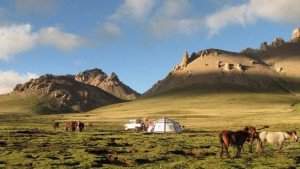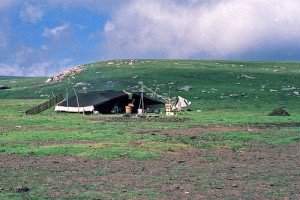The hung maul nation, who spoke Hungarian and lived in certain parts of Tibet

According to alfahir.hu, Karl F- Gützlaff, German missionary visited Hungary in the 19th century and reported on the hung mauls, a tribe that spoke Hungarian and lived in certain parts of Tibet. As the contemporary press documented it, people interested in the origins of the Hungarians got very excited after hearing the news. László Berzenczey, captain of cavalrymen and world traveler started his quest a few years later to find the eastern tribesmen of the Hungarians.
RELATED ARTICLE: Magyarabs, a Hungarian tribe in Africa
László Berzenczey wasn’t only a great patriot, public figure and heroic soldier in the age of reforms, but he also played an important role in the protohistoric research of the Hungarians since he traveled to the region where our ancestors lived once. Probably nobody would’ve found tribes speaking Hungarian there; however, he could’ve found tribes who were once in close relationship with our ancestors. Unfortunately his expedition didn’t turn out as planned due to the political conditions at the time, and he didn’t find out whether or not that particular nation lived there. In spite of this, his trip wasn’t useless as it turned out that there was much to be explored!
The critics of explorers who tried to look for our origins in the East were usually eager to freak out at opportunities like this and for instance sarcastic reports were published about Berzenczey’s trip as well. Alfahir.hu’s article tried to enlighten the topic from a new angle and prove that the Kuku-Nor region could be an exciting aspect when studying Hungarian prehistory.

We should start off with the biggest Hungarian east-researcher, Sándor Kőrösi Csoma. The Szekler scientist analysed the Tibetan language to find data concerning the origins of the Hungarians who he thought to be the descendants of the Huns. As Le Calloch writes, the great scientist firmly believed in the Hun origin of the Hungarians throughout his life and even looked for relics in East Tibet to prove his right. He found Mongol regions especially important for research because he thought that, with the help of the Tibetan language, he could talk to Mongols living in the Lamaist monasteries in the Kuku-Nor region, in the heart of the onetime Hun Empire.
The research of the Inner Asian relations of Tibet was in the centre of attention a few years ago. Young researcher rediscovered the reports of 19th century travelers. Firstly, the Russian Potanin traveled around Mongolia and later also got to Tibet. During his trip to collect folk poetry he realised that the stories of the Tibetan Kam region originate from the region of the Yellow River (it later turned out that the story takes us back to Sumerian times). New written relics were found by Aurél Stein, who made the scrolls of the Dunhuang cave library public property. This is how the analysis of the early Tibetan history started in the beginning of the 20th century. The documents revealed the ancient past of the Himalaya region, which was dominated by the Scythians and Huns. Next, it was Nicholas Roerich who traveled there in the 1920s and compared the old finds of Tibet to the relics of the Gothic culture. Today we now that the nations mentioned afore took over the Scythians’ material and mental literacy when living on the East European Plateau.

Alfahir.hu writes that the most outstanding scholar of the Tibetan history and civilisation was the Italian Giuseppe Tucci, who arrived in Tibet in 1937 and set out significant statements about the region’s past. He wrote that the origin of the Tibetan nation was complex, since, after the ancient Hun-analogical qiang nation, the Scythians were present, who were followed by the Tu Yu Huns, called Turk-Mongols by Tucci.
Today, most Tibet researchers admit that there was constant wandering at the Top of the World. The beginning dates of the wandering are not known, but a strong relationship was certainly formed between the Inner Asian region and Tibet from the 2nd millennium BC. The best examples of this are the Inner Asian and Siberian tombs from the Bronze Age, and the similarities between the sacrificial places. Mongol researchers living in China believe that Tibet was part of the Hun Empire as they found that the qiang tribe, determining in the life of Tibet, was present there. The ethnic group continued the Hun heritage and some of them still live near the Kuku-Nor.
Photos: www.alfahir.hu
Copy editor: bm
Source: http://alfahir.hu/





